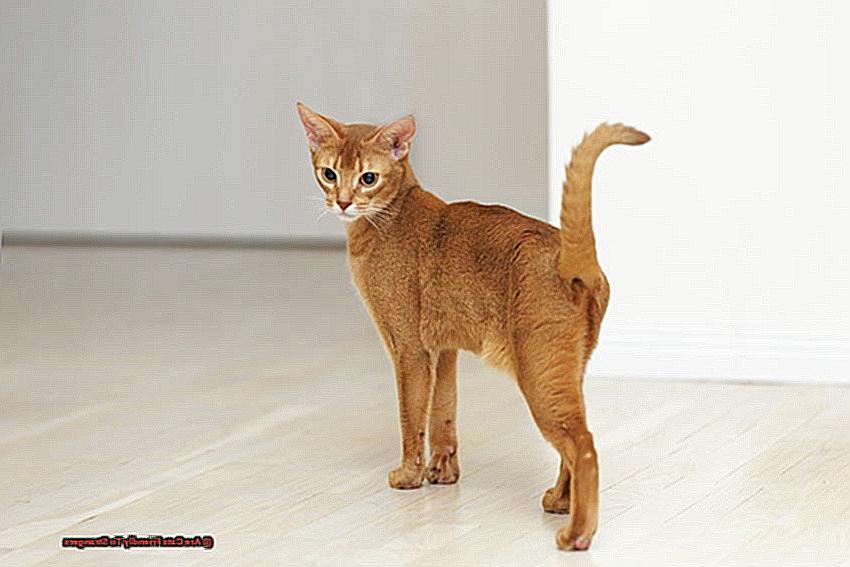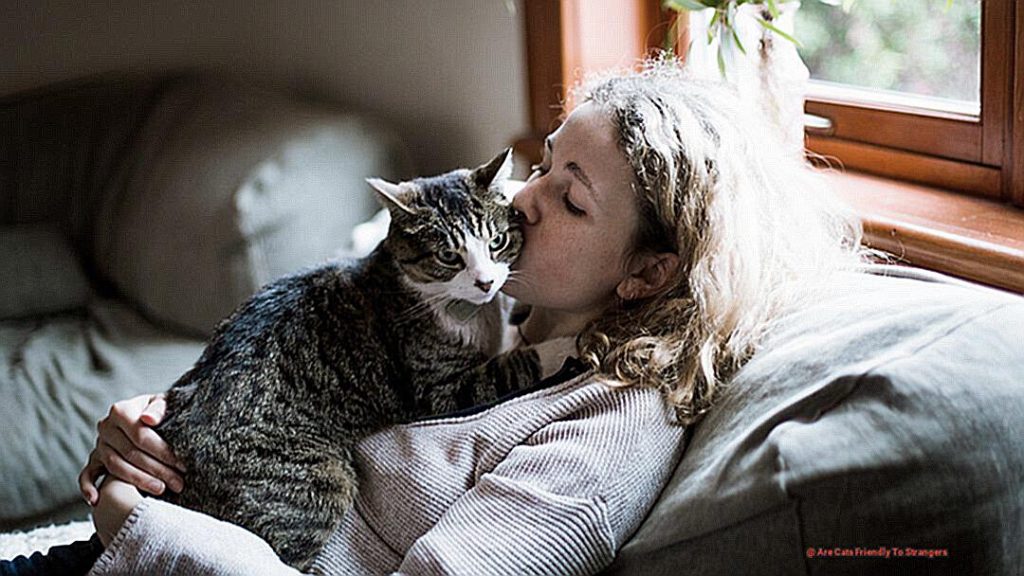Are you ready to uncover the truth about our feline friends’ behavior towards strangers? As proud cat owners ourselves, we know how puzzling it can be when your furry companion greets a new face with either a hiss or a purr.
But fear not, dear readers, for we have delved into this topic and are excited to share our insights with you. So sit back, relax, and prepare to have your perceptions of cats’ friendliness towards strangers challenged.

We promise it will be an enlightening journey.
Are Cats Friendly To Strangers?
Contents
The answer is not a simple yes or no. While cats may not be as naturally sociable with strangers as dogs are, they are still capable of forming bonds with new people. Let’s explore this topic further and understand what factors can influence a cat’s friendliness towards strangers.
- Individual Personality: Just like humans, cats have their own unique personalities. Some may be naturally more outgoing and sociable, while others may be shy and reserved. It’s important for cat owners to understand and respect their pet’s individual personality. Don’t force your cat to interact with strangers if they seem uncomfortable or anxious. This can only make matters worse and cause your cat to become even more wary of strangers.
- Breed Differences: Certain cat breeds are known for being more sociable and friendly towards strangers. For example, the Siamese and Abyssinian breeds are known to be outgoing and curious towards new people. On the other hand, breeds like the Russian Blue tend to be more reserved and may take longer to warm up to unfamiliar individuals. If you’re looking for a sociable cat, do some research on different breeds before adopting.
- Age: Socialization plays a key role in how friendly cats are towards strangers. Kittens who are exposed to different people and environments from a young age are more likely to be comfortable around strangers as adults. On the other hand, cats who have had limited socialization may be more wary and cautious around new people. If you have an adult cat who hasn’t been properly socialized, it may take more time and patience for them to become comfortable around strangers.
- Past Experiences: Like humans, cats can also develop fears and trust issues based on past experiences. If your cat has had negative encounters with strangers in the past, they may become defensive or aggressive towards unfamiliar individuals. It’s important to understand your cat’s history and behavior towards strangers before introducing them to new people. This can help prevent any potential negative interactions.
The Role of Socialization in a Cat’s Friendliness towards Strangers
You want your feline companion to be friendly and comfortable around strangers. However, many cats can be timid or even aggressive towards people they don’t know. So, what exactly influences a cat’s friendliness towards strangers?
One crucial factor is socialization. This is the process of exposing a cat to different people, animals, and environments during its early developmental stages. Typically, this occurs between 3 weeks and 14 weeks of age.
Proper socialization helps cats become comfortable and adaptable in various situations. It also plays a significant role in their friendliness towards strangers. Cats that are well-socialized are more likely to approach and interact with unfamiliar individuals without fear or aggression.
On the other hand, a lack of socialization can lead to fear and aggression towards strangers. It can make it difficult for a cat to interact with unfamiliar people, making them seem unfriendly or aloof.
It’s essential for cat owners to understand that socialization is not just about exposing their kitten or cat to different people. It’s about doing so in a positive and controlled manner. This means introducing your cat to new individuals gradually and providing plenty of positive reinforcement, such as treats or praise.
But why is socialization so crucial during the early stages of a cat’s life? This is because their brain is still developing, and they are more open to learning and forming new associations. The more positive experiences a cat has with strangers during this time, the more likely they are to view them as non-threatening and even enjoyable.
Conversely, negative experiences during this period can have long-term effects on a cat’s behavior towards strangers. If a kitten is not properly socialized, they may have difficulty adjusting to new environments and may become fearful or anxious when encountering new people or places.
Proper socialization also helps cats learn appropriate behaviors when interacting with strangers, such as not scratching or biting. It is crucial to teach your cat these behaviors early on to prevent any potential issues in the future.
In addition to socialization, a cat’s individual personality and past experiences can also play a role in their friendliness towards strangers. Some cats may naturally be more outgoing and sociable, while others may be more reserved and cautious. However, socialization is still a crucial component in shaping a cat’s behavior towards strangers.
Understanding Territorial Behavior in Cats and Its Impact on Interactions with Strangers
Cats are known for their independent and aloof nature, but did you know that their territorial behavior can also play a significant role in how they interact with strangers? As an expert on cat behavior, I have seen firsthand how this instinct can impact a cat’s interactions with unfamiliar individuals. In this blog post, we will delve into the topic of territorial behavior in cats and explore how it affects their interactions with strangers.
Understanding Territorial Behavior in Cats
Before we dive into the impact of territorial behavior on cats’ interactions with strangers, let’s first understand what it is. Cats are territorial animals, meaning they have a strong attachment to their territory, which includes their home and surrounding areas. This behavior is instinctual and stems from their wild ancestors who needed to protect their territory from other animals.
Cats mark their territory through scent, scratching, and vocalization. These behaviors can be perceived as aggressive by strangers, but it’s merely the cat’s way of establishing their ownership of their territory and communicating with other cats. When a stranger enters a cat’s territory, the cat may feel threatened and display defensive behaviors such as hissing, growling, or even attacking.
Factors That Influence a Cat’s Friendliness Towards Strangers
Not all cats display aggressive behavior towards strangers. Some may be more social and open to interactions with new people, while others may be more reserved and cautious. Several factors can influence a cat’s friendliness towards strangers:
- Early Socialization: Kittens that have been exposed to different people and environments during their early development may be more comfortable with strangers compared to those who have had limited socialization experiences.
- Breed: Certain breeds, such as Siamese and Sphynx, are known to be more sociable and outgoing towards both humans and other animals. On the other hand, some breeds like Maine Coons and Persians tend to be more reserved and less welcoming towards strangers.
- Individual Personality: Just like humans, cats have unique personalities that can vary from one another. Some may be naturally more shy and independent, while others may be more outgoing and sociable.
How Past Experiences Shape a Cat’s Attitude Towards Strangers
While some cats may eagerly approach new people, others may hide under the bed or hiss at anyone who comes near. So, what exactly influences a cat’s attitude towards strangers?
The answer lies in their past experiences and socialization. Just like humans, cats can develop certain behaviors and attitudes based on their previous encounters.
Positive experiences with strangers, such as receiving treats or affection, can shape a cat’s attitude to be more friendly and welcoming towards new people. On the other hand, negative experiences, like being scared or harmed by a stranger, can create a fear or aggression towards them.
This is why proper socialization is crucial in developing a cat’s attitude towards strangers. Kittens who are exposed to different people and environments at a young age are more likely to be comfortable around strangers as adults.
But it’s not just early experiences that impact a cat’s behavior towards strangers; their breed also plays a role. Some breeds, like Siamese and Abyssinian cats, are known for their outgoing and friendly personalities, while others, like Persians and Scottish Folds, tend to be more reserved and shy.
However, it’s important to remember that each cat is an individual and may not always follow breed stereotypes. So while certain breeds may have a tendency to be more or less friendly towards strangers, their individual experiences can still override this trait.
The environment a cat is raised in can also affect their attitude towards strangers. Cats who live in busy households with frequent visitors may become desensitized to new people and be more open to interactions, while those in quieter homes with minimal visitors may be more wary of strangers.
Factors That Influence a Cat’s Friendliness Towards Strangers: Breed Differences
For many cat owners, understanding their feline friend’s behavior and personality is a never-ending quest. One aspect that can be particularly puzzling is how their cat interacts with strangers. Some cats may be quick to make new friends, while others may take a bit more time to warm up. Interestingly, a cat’s breed can play a role in their friendliness towards strangers.
Different breeds of cats have distinct personalities and characteristics, and this can extend to how they behave around unfamiliar people. Here are some key factors to consider when looking at how breed influences a cat’s attitude towards strangers:
Outgoing vs. Reserved Breeds
Some breeds, like the Siamese and Sphynx, are known for their outgoing and social nature. They may be curious and welcoming towards strangers, even seeking out attention from new people. On the other hand, breeds such as the Scottish Fold and Persian tend to be more reserved and may take longer to warm up to strangers.
Vocalization
Cats communicate through vocalizations, and this can also play a role in their interactions with strangers. Siamese cats are known for their loud meows and purrs, which they may use to express excitement or interest in meeting new people. Other breeds may not be as vocal or may use different vocalizations that can be interpreted as either friendly or unfriendly.
Body Language
A cat’s body language can reveal a lot about how they feel towards strangers. For example, the Bengal breed is known for its confident and active nature, and they may approach a stranger with curiosity and playfulness. In contrast, breeds like the British Shorthair may exhibit more cautious body language around strangers, such as keeping a distance or exhibiting defensive behaviors like hissing or swatting.
Upbringing and Socialization
While breed tendencies can give us a general idea of how a cat may behave towards strangers, it’s essential to remember that every cat is an individual with its own unique personality. A cat’s upbringing and early socialization also play a significant role in their behavior towards strangers. A well-socialized Persian cat, for example, might be just as outgoing and friendly towards strangers as a Siamese or Sphynx.
Tips for Introducing Your Cat to New People and Helping Them Feel Comfortable
Many cats are known for being independent and aloof, making it challenging for them to warm up to new people. But before you give up hope, know that with the right approach, most cats can learn to be friendly towards strangers.
As an expert on introducing cats to new people and helping them feel comfortable, I have gathered valuable research notes and context to share with you.
Why is addressing this topic important? While cats may not be as social as dogs, they still need proper socialization to feel comfortable and confident in their environment. This is especially important during their early stages of development. Just like humans, cats can have varying levels of comfort when it comes to interacting with strangers. By addressing this topic, you can help your cat become more sociable and reduce fear and aggression towards unfamiliar people.
So how can you help your cat feel more at ease around strangers? The key is to introduce them gradually and provide a positive experience. Start by allowing your cat to approach and investigate the new person at their own pace. It’s essential to create a safe space for your cat to retreat to if they feel overwhelmed, such as a quiet room or their favorite hiding spot. This will give them a sense of security and control in the situation.
Using treats or toys can also help your cat associate the new person with positive experiences. Remind visitors not to force interactions with your cat and let them come to the cat when they feel ready. If possible, have the new person offer food or treats to the cat as this can help build a positive association. However, if your cat is still skittish around strangers, don’t worry. It may take time for them to warm up and feel comfortable.
It’s essential to respect your cat’s boundaries and not force them to interact with strangers if they are not ready. Overwhelming your cat with too many new people at once can also be counterproductive. Start with one person at a time and slowly increase the number of people over time. Give your cat plenty of attention and affection after meeting new people. This will help them feel secure and reassured.
You may also want to consider using calming aids, such as pheromone sprays, to help your cat relax in new situations. These products mimic natural feline pheromones, which can have a calming effect on cats. Additionally, seeking advice from a professional behaviorist can provide specialized tips and strategies for cats who have had negative experiences with strangers in the past.
Signs That Indicate Your Cat May Not Be Friendly Towards Strangers
Cats are known for their independent and sometimes aloof nature, but that doesn’t mean they are not capable of forming strong bonds with their owners and other animals. However, when it comes to strangers, cats can display a range of behaviors that may indicate they are not too fond of them.
As an expert on cat behavior, I am here to help you recognize the signs that your feline friend may not be welcoming to strangers.
Body Language:
The first and most obvious sign to look out for is your cat’s body language. Cats who are not friendly towards strangers may exhibit tense and rigid body posture, with their ears back and tails flicking or held low. They may also hiss, growl, or swat at the stranger in an attempt to intimidate them. If you notice these behaviors, it’s a clear indication that your cat is not comfortable with the stranger’s presence.
Avoidance:
Another way cats may show their dislike for strangers is by avoiding or hiding from them. Cats who are wary of strangers may retreat to a safe hiding spot when someone new enters their environment. This could be under the bed, in a closet, or behind furniture. Some cats may even refuse to come out until the stranger has left. This behavior is a defense mechanism and shows that your cat is not willing to interact with unfamiliar people.
Aggression:
In some cases, cats may display aggressive behavior towards strangers as a way to protect themselves. This can include biting, scratching, or even attacking the stranger. Cats may resort to aggression when they feel threatened or uncomfortable around someone they don’t know. If your cat shows signs of aggression towards strangers, it’s important to seek professional help to address the underlying cause.
Vocalizations:
Pay attention to your cat’s vocalizations as well. Cats who are not friendly towards strangers may hiss, growl, or yowl when approached by someone new. They may also make low guttural sounds as a warning to stay away. These vocalizations are a way for your cat to communicate that they are feeling anxious or threatened.
Conclusion
In conclusion, while cats may not have the same innate friendliness towards strangers as dogs do, they are still capable of forming strong bonds with new people. A cat’s individual personality, breed differences, age, and past experiences all play a role in their willingness to interact with unfamiliar faces. However, it is important for responsible cat owners to understand that proper socialization is crucial in shaping a cat’s behavior towards strangers.
Socialization should be done in a positive and controlled manner, allowing your cat to gradually become comfortable with new people. It is also essential to recognize and respect your cat’s territorial behavior and boundaries when introducing them to strangers. This can help improve their interactions and prevent any potential aggressive behaviors.
As loving owners, it is our responsibility to pay attention to our cats’ body language and behaviors around strangers. Signs such as tense posture, avoidance behaviors like hiding or retreating, and aggressive vocalizations or actions can indicate their discomfort. In these situations, it is best to give your cat space and seek professional help if needed.
With patience and understanding, even the most aloof cats can learn to be friendly towards strangers. By providing them with positive experiences and respecting their boundaries, we can help them become more confident in interacting with new people.






